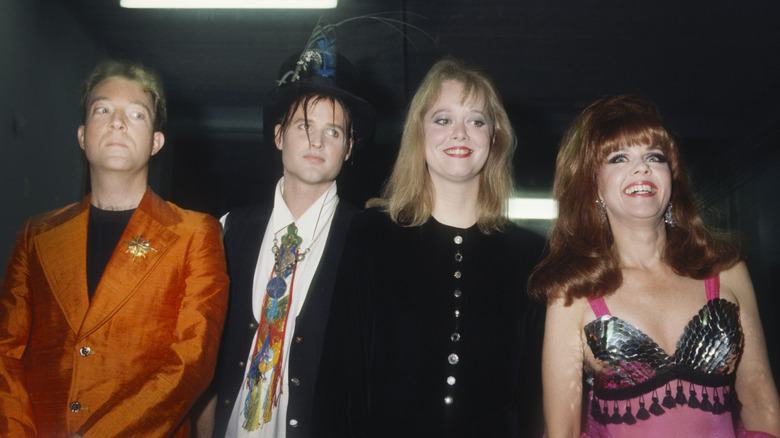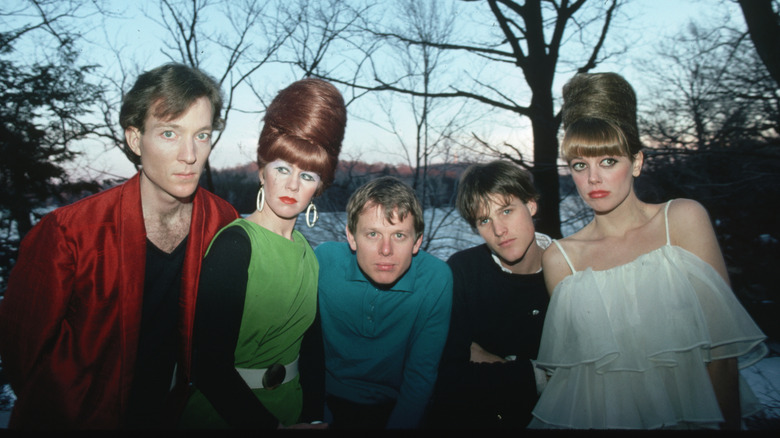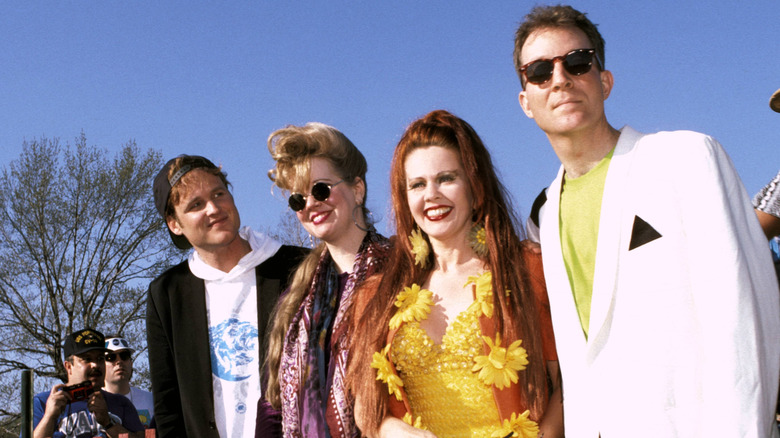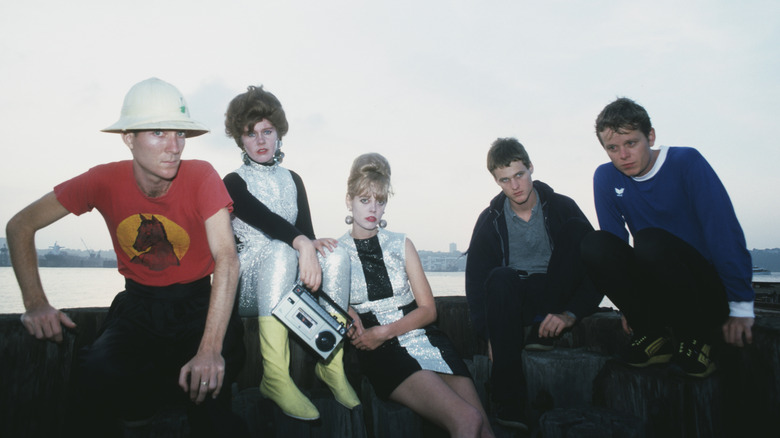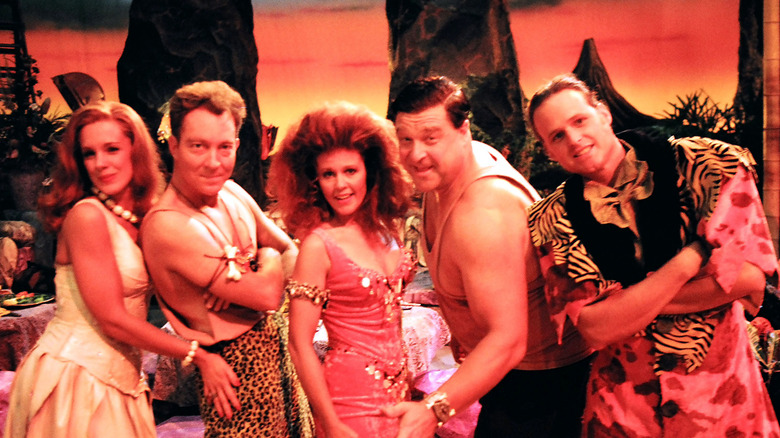The Hidden Truth Of The B-52's
While punk and new wave came bursting out of the big cities in the late 1970s, Athens, Georgia, gave the world the B-52's. With a unique, garage rock sound both raw and poppy, the band scored big with "Rock Lobster," and then built up a cult following in the early '80s among the young and the hip with songs like "Planet Claire," "Private Idaho," and "Song for a Future Generation." At the end of the decade, the B-52's finally found commercial success with pure pop confections like "Love Shack," "Channel Z," and "Deadbeat Club," but maintained what set the band apart — its humor, its inability to take itself or anything seriously, not to mention the memorable guitar riffs, the boisterous talk-singing of Fred Schneider, and the sunny forceful vocals of Kate Pierson and Cindy Wilson.
The B-52's are responsible for some of the best crowd-pleasing party music ever, and they're indie rock icons. As the band winds down its nearly 50-year existence in the 2020s, grab your matching towels; here's the wild history of the B-52's.
The B-52's was nearly the Tina-Trons
Some people start bands because they have a passion for music or a drive to create lasting art. The driving force behind the band that would become the B-52's, apart from self-expression, was boredom. "It was deadly dull, which required that you just make your own fun," singer Fred Schneider told T. Cole Rachel regarding the college town of Athens, Georgia, in the 1970s. Locals Keith Strickland and Ricky Wilson had been close friends since childhood and hung out with Ricky's sister, Cindy. They also grew close with a couple of new people in town; health food store worker Fred Schneider and Kate Pierson, who lived in the outskirts of town and tended to a flock of goats. While out for dinner one night, they decided that they ought to start a band.
With that decision made, the group of Athens young adults knew they needed a name. The first ideas were non-starters: neither the Tina-Trons nor Fellini's Children (after artsy mid-20th century Italian director Federico Fellini) seemed to fit. While the band started to become more active, drummer Keith Strickland experienced a dream where he and his friends were performing at a hotel bar. Inside the dream, somebody whispered to him that the name of his band was the B-52's. And that became the name of Strickland's band in real life, too.
The kitschy world of the B-52's
Kitsch, or embracing older, passé pop culture and fashions and reappropriating them later in a semi-ironic but appreciative manner, is a big part of the entire B-52's story. The very name of the group is the same as that of the B-52 haircut, also known as a beehive, briefly popular in the early 1960s, and which singers Cindy Wilson and Kate Pierson rocked in the early years of their band, along with appropriate accessories like false eyelashes. In other nods to the past, the band members favored old, tacky, and colorful clothing procured from secondhand shops. "We had no money and bought clothes that we liked," singer Fred Schneider explained to Billboard.
Even on the night that the B-52's was born, kitsch was a factor. Five friends gathered at Athens, Georgia's Hunan Chinese Restaurant in Athens and split a massive novelty cocktail called a Flaming Volcano. By the end of an evening spent drinking sugary mixed booze that had been set aflame, they'd endeavored to form a band. The band also played on decades-old and outdated recording equipment.
Fred Schneider loves lobsters, rock or otherwise
The B-52's remain widely known for its first single, the 1979 cowbell, riff, and organ-driven "Rock Lobster." Fred Schneider delivers surreal lyrics about a strange beach party where somebody goes under a dock and finds a rock, but it's actually a rock lobster, the first of many odd sea creatures that make an appearance in the song. It all may seem like a lark or a novelty, but Schneider, who co-wrote the song with B-52's guitarist Ricky Wilson, has strong feelings about crustaceans.
At the age of 4, Schneider went on a family crabbing excursion in New Jersey, where he witnessed the shellfish get cooked by being boiled while it was still alive, a standard preparation. Schneider never ate a crustacean again, and he subsequently adopted a vegetarian lifestyle. In the mid-1970s, he got the idea for the song when he went to an Atlanta nightclub called the 2001 Disco. "Instead of a good light show, they just showed slides of puppies and babies and cooked lobsters on a grill," Schneider told Entertainment Weekly." And I just thought, 'Wow, well, rock this, rock that, rock lobster.' And then I went back to Athens, where we rehearsed in the bloodletting room of this old Black funeral home, and 'Rock Lobster' came out of that." By 2014, Schneider, long associated with lobsters due to his position with the B-52's, starred in an anti-lobster consumption campaign for People for the Ethical Treatment of Animals.
The B-52's inspired John Lennon and Yoko Ono to make music again
The debut recording by the B-52's, the winsome and wacky new wave-meets-surf rock single "Rock Lobster" wasn't born in a vacuum. The band took cues from Yoko Ono, who was well known for her relationship with the Beatles' John Lennon, but was also a musician in her own right, albeit an experimental and non-mainstream one. "Cindy does this scream that was inspired by Yoko Ono," B-52's guitarist Keith Strickland told Q (via Far Out) of Cindy Wilson's marine animal-like howls in the song."
When he heard that record for the first time, Lennon understood and appreciated the reference. "I was at a dance club one night in Bermuda," Lennon told Rolling Stone a few days before he died in 1980. "I suddenly heard 'Rock Lobster' by the B-52's for the first time. Do you know it? It sounds like Yoko's music." That in turn inspired Lennon to return to music — he'd retired in 1974 to raise his son — and team up with his wife, too." He realized that my time had come. So he could record an album by making me an equal partner and we won't get flack like we used to up to then," Ono said (via Far Out). That album became Lennon's last release, "Double Fantasy."
The band had major difficulties with its manager
In the very early 1980s, the B-52's set out to both widen its appeal and explore musical avenues beyond the new wave rock to which it was accustomed. Front man Fred Schneider wanted to pursue a sound rooted in soul, funk, and other forms of music historically pioneered by the Black American community. This didn't sit well with the band's manager at the time, Gary Kurfist. "Our ex-manager, for reasons I think were suspicious, asked why we wanted to change our popularity. I said we want everybody to like us," Schneider told Flood Magazine. "I like soul and funk better than I like rock and roll, so who cares?" Schneider believes the manager downplayed their experimentation so as to keep the spotlight on another client. "The next thing you know, his other band, the Talking Heads, comes out with this whole funk thing. We were used to promote them."
At Kurfist's insistence, the story of the Talking Heads' leader David Byrne included a stint as producer on the third B-52's album, in 1981. What resulted from the sessions was a short EP, "Mesopotamia." "Our manager was pushing us, pushing us to get the next record out," singer Kate Pierson told Stereogum. "We talk about it now and we wish we could go back and finish."
The B-52's endured the death of its guitarist
Over the first few B-52's albums, the majority of the songwriting duties were handled and led by guitarist Ricky Wilson and drummer Keith Strickland. When the band convened to start what would become its 1986 album "Bouncing Off the Satellites," the duo suggested main vocalists Fred Schneider and Kate Pierson compose more independently. "That was a dark moment. We felt like, 'Why is this happening? Why are we being marginalized out of the band?'" Pierson told Stereogum. The reason was that Wilson had quietly grown very sick, and writing a whole album on his own was too daunting a task in his weakened condition. "I realized a long time later that that's why that happened."
Wilson kept his illness a secret, even from his bandmate and sister, Cindy Wilson. "Nobody even knew he was sick until he was in the hospital," Schneider told Entertainment Weekly. The only B-52 aware that the guitarist was dying was Strickland, his roommate and best friend. In a sad and tragic chapter in the messed up history of AIDS, Ricky Wilson died in 1985 at age 32 from complications of the disease.
The B-52's embraced the mainstream and it worked out
Following the 1985 death of Ricky Wilson in 1985, the B-52's embarked on an indefinite hiatus. "We thought the band was finished because we couldn't imagine continuing without him," Strickland told The Daily Mail. But two years later, Strickland called up the others and announced that he'd processed his grief through songwriting. He had enough songs ready to prepare a new album. "We started realizing we had something so precious together," singer Kate Pierson told Billboard. "And Ricky's spirit returned in a way. It was a real healing process."
Wilson's death left the band without a guitarist. By that point, Strickland had completed his transition from drummer to lead guitarist, having taught himself to play the instrument not only at a professional level, but in a way that emulated and replicated Wilson's technique.
In the studio, Strickland ceded his old instrument to a drum machine, which worked well with the bright, slick, and poppy sound that the B-52's pursued. Along with Don Was, Nile Rogers' award-winning music career also took him to the B-52's, and together they guided the process of "Cosmic Thing," released in 1989. It hit No. 4 on Billboard's album chart (the B-52's highest showing ever there) and spawned the group's only top five hits, "Roam" and "Love Shack." "It really is amazing that 'Cosmic Thing' is such a happy album," singer Cindy Wilson said, "because it came from grief and sadness."
Inside the Love Shack
"Love Shack" is by far the B-52's most popular song in terms of streams and charts. The Love Shack might be a real place, although there's no united front from the band on a singular inspiration. "There's a place in the middle of nowhere outside Athens called the Hawaiian Ha-Le. It just looked like a shack, but once you get inside it's, like, this fabulous fun disco," Fred Schneider told Entertainment Weekly, adding that bandmates Kate Pierson and Cindy Wilson "had their own ideas of what a love shack would be."
For Wilson, it was a shut-down joint near Athens topped with a rusted metal roof. "It was just part of a description of the vision in my head of what the love shack looked like," Wilson told MLive. While recording "Love Shack," the playback tape stopped but Wilson kept going, and ad-libbed the shouted lyric "Tin roof, rusted!" That moment led to a well-traveled myth that the line is old Southern euphemistic slang that refers to getting pregnant. "That line has nothing to do with pregnancy," Schneider said. "There's just a lot of tin roofs in Georgia."
Once the B-52's finished making "Cosmic Thing," the band determined that "Love Shack" was an obvious choice for a single. But the band still had to overcome a reputation as making strange, non-commercial music. Schneider and a Reprise Records representative traveled around to American radio stations and personally implored them to play the song.
The B-52's is an iconic band in the LGBT community
The B-52's was always the kind of band who just did things its own way, while it was also quietly breaking down barriers and diversifying mainstream rock music. It was also one of the first major acts to openly use language, iconography, and sensibilities strongly and historically associated with the LGBTQ+ community. "We just did our own thing," Fred Schneider told Billboard. "I guess subconsciously we were trying to say something. But it was sort of stream of consciousness, it was so out there."
For example, the video for the group's biggest-ever hit, "Love Shack," featured an early appearance by drag performer RuPaul, way back in the relatively more conservative year of 1989. Of the band's original five members, four musicians, including deceased guitarist Ricky Wilson, drummer-guitarist Keith Strickland, as well as singers Schneider and Kate Pierson, have self-identified as LGBTQ people.
The B-52's loves its cartoons
The B-52's are as much of a visual band as a musical one, as well as the self-proclaimed "World's Greatest Party Band." In many ways it's a cartoonish group of musicians, so it made sense that the B-52's have embraced the many opportunities it was presented to contribute to animated projects and the like.
After "The Simpsons" theme song composer Danny Elfman passed on recording the theme song for Nickelodeon's "Rocko's Modern Life," Kate Pierson and Fred Schneider of the B-52's got the gig. The band also contributed a track to the "Pokémon The Movie 2000" soundtrack, the Adult Swim pilot "The Groovenians," and in for "E-I-E-I-(Annoyed Grunt)," a 1999 episode of "The Simpsons," the B-52's recorded a parody of its own "Love Shack" called "Glove Slap," referring to Homer Simpson's habit of challenging others to duels in the traditional manner.
For the big-budget, live-action film adaptation of 1994's "The Flintstones," a show with a lot of dark parts, the B-52's made a cameo appearance in character as a Stone Age rock band called the BC-52's. "We got to ride in one of those little 'Flintstones' cars where you move it with your feet," Pierson told Stereogum. "We did 'The Bedrock Twitch' and the 'Flintstones' theme. I wish we could do that live." That new version of the old song by the classic band pretending to be ancient made the Top 40 in the U.S. and reached No. 3 in the U.K.
Band members' solo projects are never really solo projects
For various personal and professional reasons, the members of the B-52's have historically given themselves plenty of time between albums. In the 1980s, three years passed between "Bouncing Off the Satellites" and "Cosmic Thing," and then after that major commercial breakthrough, the band waited until 1992 to release "Good Stuff." By that point, Cindy Wilson had left the B-52's to concentrate on her children, returning in 1994 for touring and again in 1998, when she sang on two new songs on a greatest hits album. Wilson left again in 1999, came back in 2001, and participated in the group's last studio album to date, 2008's "Funplex."
Afterward, Wilson befriended some musicians from her hometown of Athens, Georgia, and put together some EPs and albums. Her second record, "Realms," featured the drum work of longtime B-52's touring member Sterling Campbell. That mirrored an earlier move by other people in the B-52's. On a break from the band in 1984, Fred Schneider created a side project called Fred Schneider and the Shake Society. Its self-titled, one and only album featured another B-52, Kate Pierson, on four of the nine tracks, including the minor hit "Monster."
